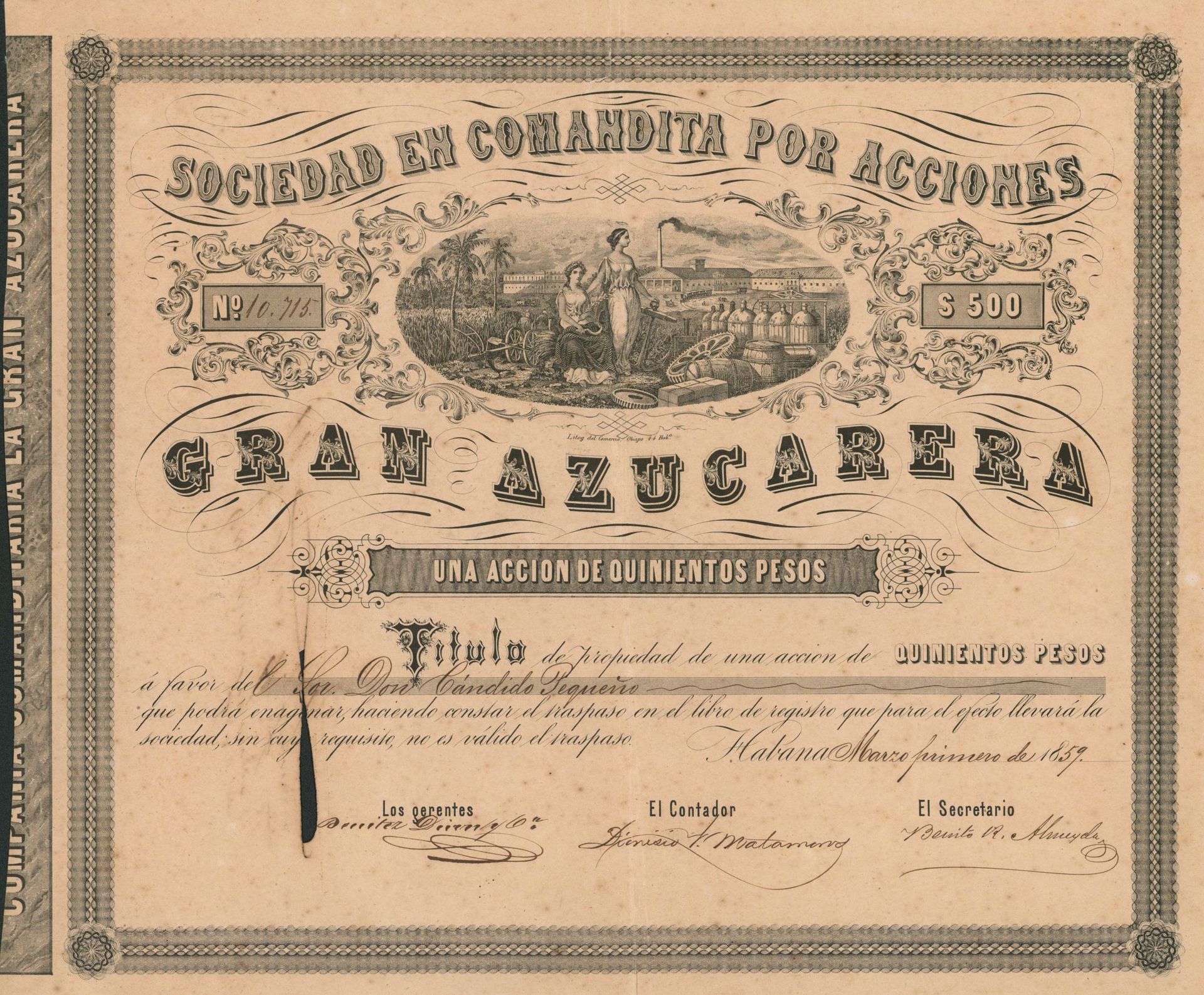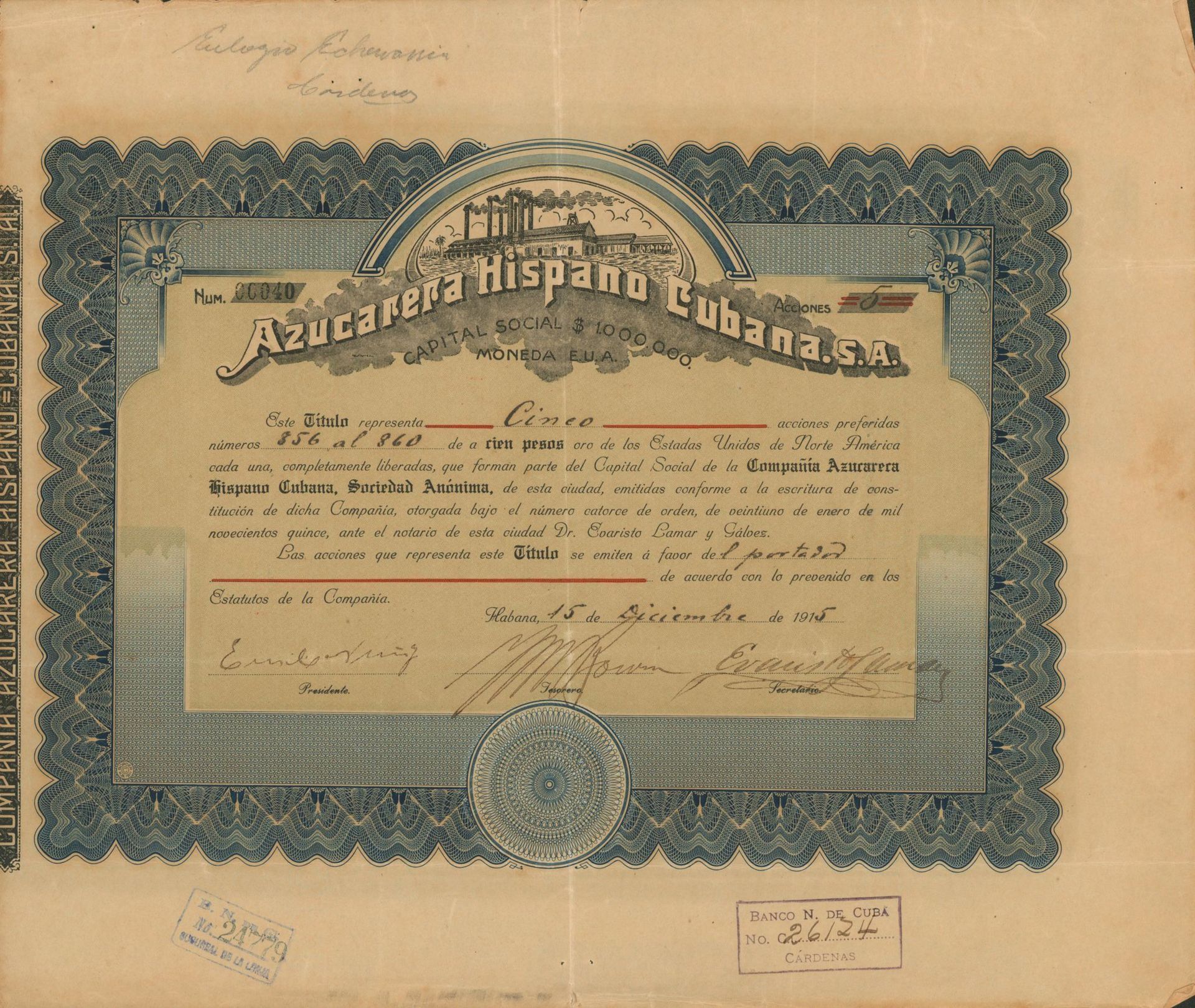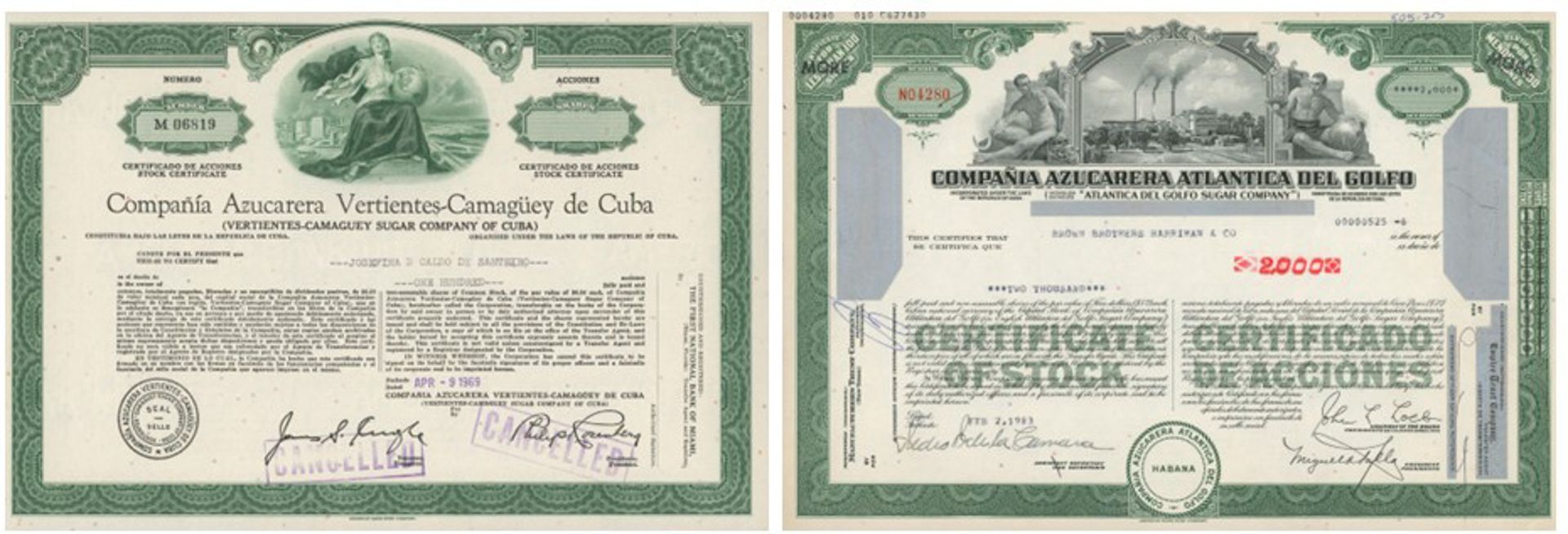
Cuba. The local companies and their scripophily
Cuba – the local sugar companies and their scripophily
Cuba was for a long period one of the key players in the global sugar industry. From a slow start in Spanish colonial times to a major global player, through devastating wars of independence, US-occupation and reaching a pinnacle during and after WW I – followed by decline, crisis, intermittent recovery and communist revolution. Whilst US-capital and US-industrialists played a crucial role, they were not alone. A large proportion of the industry was controlled by Cubans and to a lesser extent by European – most notably Spanish - interests. In this article I look at those companies that were established in Cuba and their certificates – either during colonial times or under the laws of the Republic of Cuba.

The colonial period – to 1898
Propelled by the collapse of the industry in Santo Domingo, US demand for sugar and more competent management by the Spanish colonial administration the industry grew significantly. Production continued to grow sharply -It is in the context of the boom of the 1850s that the Gran Azucarera a Sociedad en comandita por acciones was established in Habana in 1857. Evidently the first major Cuban corporation active in the field of sugar acquired a number of sugar mills but ran into economic trouble and was probably bankrupt soon after 1866. The beautiful certificate of the company was locally printed and loosely follows the design patterns typical of French and Spanish certificates of the time – large format, an elaborate etching including allegorical figures, attributes and a sugar factory as well as a wavy cut on the left.

Shortly afterwards Cuba descended into civil war. Despite reaching a high in the mid-1890s, by 1899 sugar production had slipped back to the levels of the early 1850s. more than tripling from 1850 to 1870. In this period we find early evidence of corporations issuing scripophily and first attempts to build major enterprises. At the time the vast majority of sugar assets were privately held. The move from the earlier ingenios (planting and milling on the same estate and in the same hand) to the later centrales where the milling happened centrally for a number of plantations with mostly independent planters (colonos) was still in its infancy.
The Republican boom 1902 - 1920
With the establishment of the Republic of Cuba under US tutelage in 1902 conditions for heavy investment and a resurgence in sugar production were favorable. Historically Cuban sugar production was concentrated in the Havana, Matanzas and Santa Clara provinces, US investment often went into the relatively undeveloped Camaguey and Oriente provinces. By 1911 roughly a third of production was controlled by US, Cuban and European interests respectively. The Great War provided considerable impetus – of the 65 new factories built during the time of the Repulic of Cuba more than half began production in the years 1914 – 1918 and none seem to have been added after 1926. Little surprise then that some of the available scripophily comes from that period.


The typical corporate had (mortgage) bonds and common stock outstanding – in some cases also preferred shares. Let us now look at these relatively early years. The 1906 bonds issued by Ingenio Santa Gertrudis were likely refinancing earlier bonds outstanding by a Cuban-controlled company that owned the long established mill. Given the text in English and Spanish and the printing by American Bank Note Co. (ABN) the targeted investors included a US-American audience. The mill was sold to major Cuban Cane Corp around 1916. It was out of business by 1938. The preferred share issued by Azucarera Hispano Cubana and printed locally in 1915 follows the Spanish design model.

The company controlled the Gerardo central in the Pinar del Rio province. It was evidently an interim step in the incorporation of an estate originally owned by a Spanish individual – the mill would be renamed Bahia Honda in 1923 and would see at least four more ownership changes by 1938 and may still be producing today.

The bonds issued by Compañía Azucarera Elia in 1915 are indistinguishable in design terms from US pieces of the time – unsurprising as they were printed by ABN and likely targeted US-investors – by then a well-trodden path. The Cuban-controlled Compañía Azucarera Elia was established to build and operate the sizable Central Elia in the Camagüey province, Cuba. The company did not survive to 1938.

The Compañía Azucarera Pedro Fernandez de Castro owned the smallish Nuestra Senora del Carmen in the La Habana province, Cuba from 1914/15. The mill was previously owned by Pedro Fernandez de Castro (identified as Spanish). The mill capacity was extended at the time and it seems very likely that the de Castro family retained an important influence as otherwise the name of the company would have been changed. By 1938 the mill no longer existed. This certificate by ABN is a hybrid between typical US and Cuban certificates and is one of few Spanish-only certificates made by ABN in the context. Large vignette of the actual mill. Amusingly the name of the mill (which is often misspelt in the annual lists) is abbreviated - despite enough space being available. Maybe the printer was worried about getting it right…

Decline and Depression 1921 - 1934
The boom years during and immediately after WW I were followed by a bust – and then matters got worse as a consequence of the Great Depression. In terms of Cuban sugar this meant a flurry of activity as the complex web of owning, operating as well as financing companies and layers of holding companies was restructured – often several times. Mills changed hands, were idled, restarted, closed or in some cases expanded. From close to 200 mills operating in 1917 the number declined to little more than 100 in 1934.
The Compañía Azucarera “Andorra” was incorporated in 1920 and owned the medium sized central Andorra in the La Habana province succeeding the Central Lincoln Compañia Azucarera (established 1917). The name of the mill and the town was changed at that point from Lincoln to Andorra (together with ownership now in Cuban hands). The mill was nationalised as a consequence of the Cuban revolution and seems to still be operating today. In a rather cynical twist the mill was named after US president Abraham Lincoln again by the Cuban regime. Whilst the shares of the original company are US-styled and were printed by ABN the Cuban-controlled successor’s shares were locally produced and follow the Spanish model with some unusual features: A zic-zac-cut instead of a wavy cut and the number of the certificate is spelt out rather than enumerated…also a bearer certificate rather than the usual registered.

Typical bond certificate by the Hamilton Bank Note Company with a somewhat unusual vignette issued by the Compañía Azucarera Antilla set up in 1921. Two allegorical figures with trumpets standing in front of a mountain range hold a map of Cuba with a sugar mill and trees; insert is another vignette with a crane loading cane on a train. The first mortgage bonds were issued in 1924 to finance the acquisition of Tacajo Sugar Corporation owning an adjoining property which had been constructed 1916. The company was reorganized in 1931 as Ingenios Azucareras de Antillas but continued to be loss making in the 1930s. By the early 1950s the mills were controlled by Garcia Diaz y Cia.
After WWII, Revolution and beyond - 1945 and onwards
Cuba never fully recovered from the unimaginable suffering brought on its economy and society by overdependence on sugar when sugar prices and production levels fell steeply. Unsurprisingly this lead to increasing instability and undermined the legitimacy of the Republic and the functioning of the state itself – it also lead to extreme antagonism between a large number of unemployed and laborers on the one hand and capitalists, estate owners and a relatively small middle class on the other. As elsewhere the communist revolution that followed did not bring the hoped for freedom. Expropriation, central planning, underinvestment and incompetent management unfolded in the years after 1958 and the sugar industry fell apart in an increasingly literal sense. But that did not mean the end for all Cuban companies – a number of local companies continued to trade on US exchanges with investors pricing in assets under the control of US-based managements and a dwindling hope of regaining control of the assets in Cuba.
The Compañía Azucarera Central Elena is a fairly typical example of a local company and its shares in the years after WWII – there was high turnover in owning companies and scant economic success. In 1903 the central Elena, Matanzas province, is one of the smallest Cuban mills and has Spanish owners. In 1938 the mill in the Matanzas province was privately owned by two Spaniards. Presumably this company was set up to acquire the mill in 1950. It was evidently closed before the Cuban revolution. A plain certificate in the local style.

One of the companies that continued to see their shares traded was the Central Violeta Sugar Company, S.A. It was set up in 1936 in Cuba as part of the reorganisation of the Eastern Cuba Sugar Corporation and acquired some assets originally owned by Cuban Atlantic Sugar Company (to which it remained affiliated as evidenced by the companies sharing a president for quite some time). It also had acquired the large central Violeta through foreclosure - which ended up as its only producing mill. Typical certificate issued in 1960 with a more elaborate vignette - a mill with smoking chimneys set in a garden sandwiched between allegorical figures with an unclear representation. The par value of the shares had been halved to a very unusual 9.50 dollars - Cuban official currency.
The Compañía Azucarera Vertientes-Camagüey de Cuba was the operating company of Vertientes-Camaguey Sugar Company incorporated in Delaware in 1937 to accomodate the reorganization of the Camaguey Sugar Co. and the Vertientes Sugar Co. After the Cuban revolution its Cuban properties were nationalized and in February 1961 the New York Stock Exchange decided to suspend trading in the stocks of the company. Typical design for the period for the stock certificate issued in 1969. Vignette with an allegorical lady holding a globe surrounded by a modern city and a motorway - devoid of any reference to the sugar industry. The certificates continue to be in Spanish and English and the company continues to be “organized under the laws of the Republic of Cuba” - which by then had been a communist dictatorship for some time…Interestingly the transfer agent was not a Wall Street bank but The First National Bank of Miami.

The final example is the Compañía Azucarera Atlantica del Golfo – a major sugar company in Cuba. It was incorporated in 1934 as the Cuban operating company for assets previously owned by Cuban Cane Products Company. In 1938 it owned 9 mills in 3 provinces and on the eve of the revolution it controlled around 8% of Cuban capacity. Its holding company was the Cuban Atlantic Sugar Company, stock-exchange traded to at least the 1980s - but a penny stock after the Cuban revolution. Typical 1983 certificate for less than 100 shares of common stock - with a stamp replacing the “less” with “more”. Vignette with a large mill in full swing sandwiched between two allegorical young men holding attributes of agriculture, shipping and a globe - incidentally the same as on the certificates of its parent. Issued to important investment firm Brown Brothers Herriman.
Family affairs
Much of the industry in Cuba was controlled by families – initially through direct ownership but increasingly through corporations – often the equity was fully controlled by the family and investors provided debt financing. These families were often of Cuban, Spanish, British or American descent and remained active in the sugar industry over generations – and some of them still are. Interestingly the families are increasingly identified as Cuban as time passes. It seems most likely that many of the family members will have actually lived in the US and in Cuba spending part of the year in the US and part in Cuba whilst travelling frequently. To mention just a few we have Atkins, Fanjul, Fowler, Rionda and Tarafa.

Other considerations
Tracing the history of Cuban sugar mills and their corporate owners is less straight forward than in many other countries: Cuba had a large number of mills (I have identified 276 active in the Republican period) that frequently changed ownership and name and even their locations sometimes changed names. To make matters worse there was no hesitation to use the same name – no fewer than four Santa Catalinas are listed in 1907. The literature available to me covers the period of the Republic quite well but with a large gap from 1924 – 1937 for which my predominant source is English-speaking newspaper reports.
Of the 67 local Cuban company pieces in my collection the majority were printed in a style closely following US-certificates at the time – unsurprising as around 75% were printed by US firms (mostly ABN but also Hamilton Bank Note and others) – reflective of the importance of international capital and the more favorable conditions for survival (including the ABN archive as the most important source). All the locally printed certificates follow a style that resembles contemporaneous Spanish pieces.